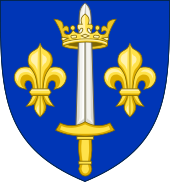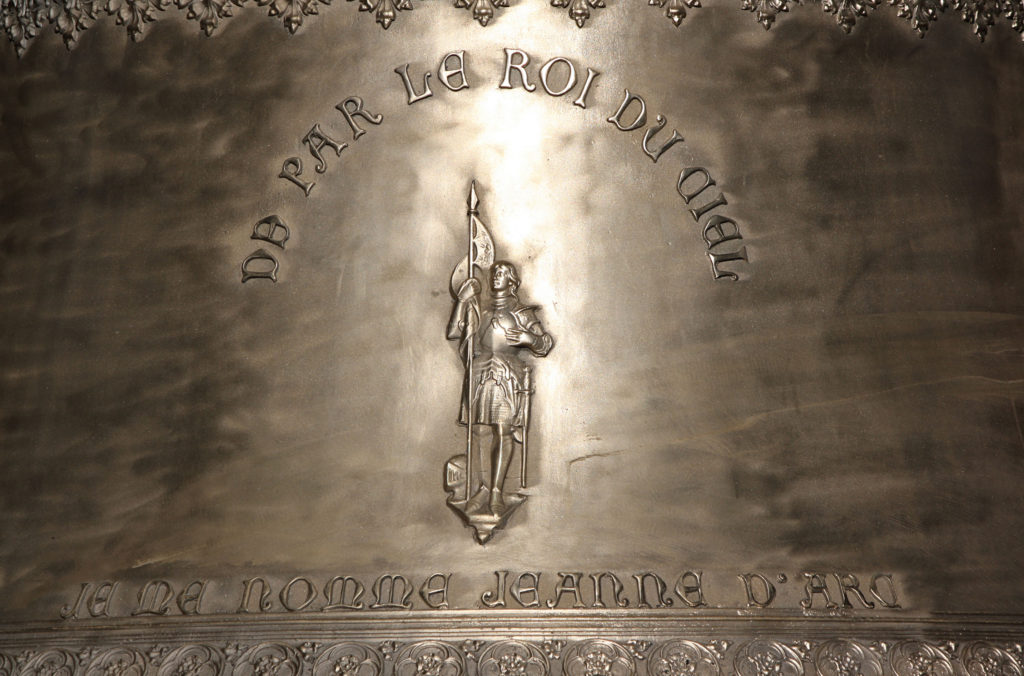IMAGES FROM JEANNE’S LIFETIME
We hope you will enjoy seeing some of these images – they are, in the most part, places which were important in Jeanne’s life – often where significant events occurred. Jeanne believes that it will help people to connect with her energies by having the opportunity to actually see where some of these things happened. Also, we have included a few images from more modern times which we feel are significant. Enjoy!
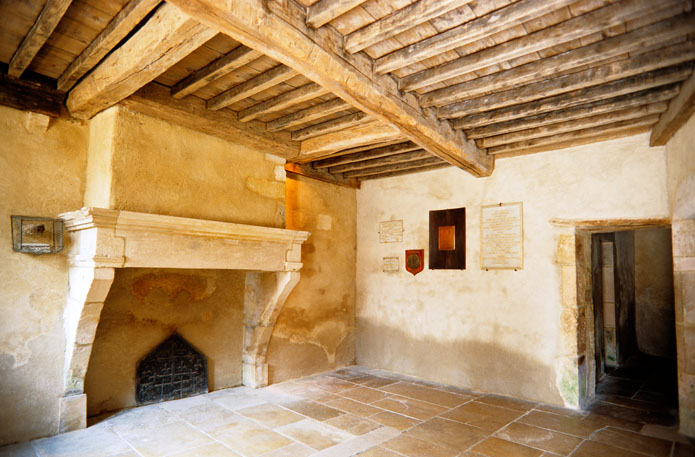 Interior view of the house where Jeanne was born.
Interior view of the house where Jeanne was born.
Located in the village of Domrémy-la-Pucelle, it is now a museum.
Photo Credit: Alamy Stock
* * *
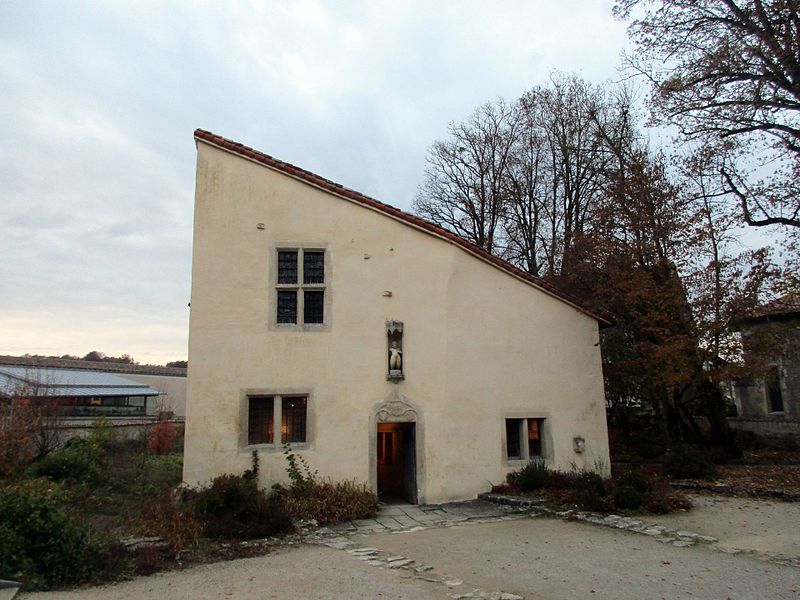 The House Where Joan was Born “Maison natale”
The House Where Joan was Born “Maison natale”
Joan’s birthplace in Domrémy is now a museum.
The village church where she attended Mass is on the right behind the trees.
Credit: By Arnaud 25 (Own work) [CC BY-SA 4.0 (http://creativecommons.org/
via Wikimedia Commons from Wikimedia Commons
* * *
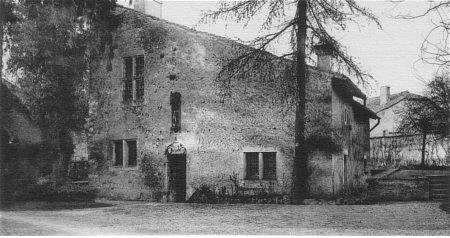 Earlier image of the house where Jeanne was born
Earlier image of the house where Jeanne was born
Domremy maison natale – The House of Joan
* * *
 Domrémy – l’église du village où a été baptisée Jeanne d’Arc
Domrémy – l’église du village où a été baptisée Jeanne d’Arc
Church located in the village of Domrémy-la-Pucelle where Jeanne
was baptized and attended services as a child and young woman
Attribution: This building is classé au titre des Monuments Historiques. It is indexed in the Base Mérimée, a database of architectural heritage maintained by the French Ministry of Culture, under the reference PA00107137
* * *
 Ruin of the great hall at Château de Chinon where Joan met future King Charles VII.
Ruin of the great hall at Château de Chinon where Joan met future King Charles VII.
The castle’s only remaining intact tower, now known as the ‘Joan of Arc Tower’,
has been turned into a museum dedicated to her.
Credit: No machine-readable author provided. LonganimE assumed (based on copyright claims).
– No machine-readable source provided. Own work assumed (based on copyright claims)
* * *
 Château de Chinon where Jeanne first met the Dauphin, Charles, and convinced him to allow her to command the Army of France. She would later succeed in her mission to convey him to the cathedral at Reims and see him crowned there as Charles VII, King of France.
Château de Chinon where Jeanne first met the Dauphin, Charles, and convinced him to allow her to command the Army of France. She would later succeed in her mission to convey him to the cathedral at Reims and see him crowned there as Charles VII, King of France.
View of the château de Chinon from the left bank of the River Vienne.
One can see to the right the clock tower and to the left the tower of the mill.
Credit: No machine-readable author provided. LonganimE assumed (based on copyright claims).
* * *
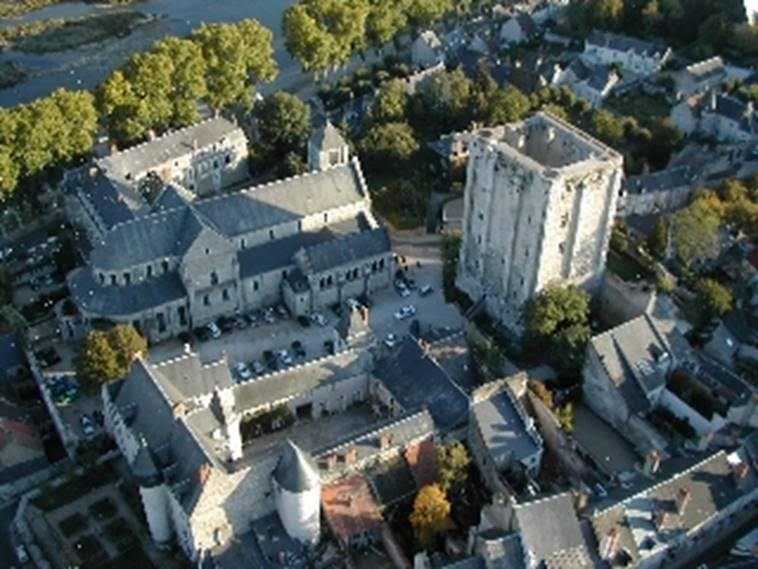 The inner keep at Beaugency is one of the few surviving fortifications from Joan’s campaigns.
The inner keep at Beaugency is one of the few surviving fortifications from Joan’s campaigns.
English defenders retreated to the tower at upper right after the French breached the town wall.
Credit: Marc Liger – Own work
* * *
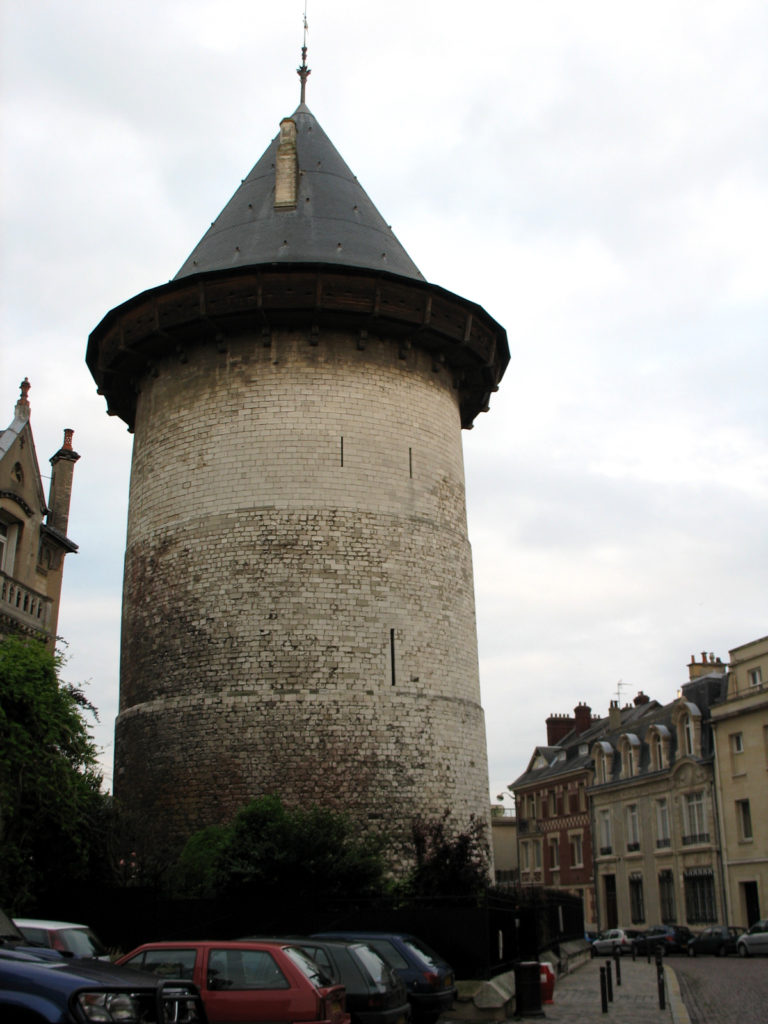 The keep of the castle of Rouen, surviving remnant of the fortress
The keep of the castle of Rouen, surviving remnant of the fortress
where Joan was imprisoned during her trial.
It has since become known as the “Joan of Arc Tower”.
Credit: Rouen, tour Jeanne d’Arc. Personal picture taken by user Urban 2005
Further Attribution: This building is indexed in the Base Mérimée, a database of architectural heritage maintained by the French Ministry of Culture, under the reference PA00101011
* * *
 Image of Notre-Dame de Reims in the present day: Site of Reims Cathedral where Jeanne d’Arc
Image of Notre-Dame de Reims in the present day: Site of Reims Cathedral where Jeanne d’Arc
saw the Dauphin Charles crowned King Charles VII of France.
After Henry V, King of England, defeated Charles VI‘s army at Agincourt, Reims along with most of northern France fell to the English. The English would hold Reims and the Cathedral until 1429 when it was liberated by Joan of Arc which allowed
the Dauphin Charles to be crowned king on 17 July 1429.
During the First World War, German shellfire during the opening engagements on 20 September 1914 burned, damaged and destroyed important parts of the cathedral. Restoration work began in 1919, under the direction of architect Henri Deneux, a native of Reims; the cathedral was fully reopened in 1938.
Credit: Author : KoS Description : Détails de la cathédrale de Reims taken on October 2005/prise en Octobre 2005
* * *
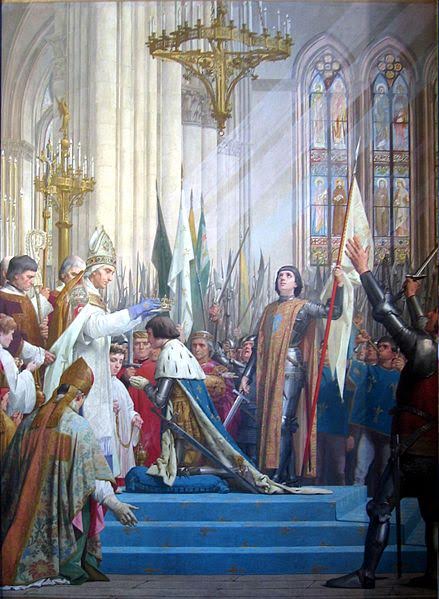 Jeanne d’Arc sees the fruition of her efforts: The Dauphin Charles is
Jeanne d’Arc sees the fruition of her efforts: The Dauphin Charles is
crowned King Charles VII of France in Reims Cathedral.
Painting of Joan of Arc, 1889-1890 in the Panthéon de Paris, by E. Lenepveu.
Credit: Tijmen Stam (User:IIVQ) – Own work.
Pictures from his trip to Paris (19-22 jan, 2007
* * *
In 1429, King Charles granted Joan a coat of arms, consisting of a crowned sword
between two fleurs-de-lis
Credit: – Own work, using elements made by user:Heralder and user:
* * *
 A plaque marking the place where Joan of Arc was burned at the stake, Old Marketplace, Rouen.
A plaque marking the place where Joan of Arc was burned at the stake, Old Marketplace, Rouen.
The plaque reads: “The location where Joan of Arc was burnt on May 30 th, 1431.”
Credit: – Own work (Own photography)
* * *
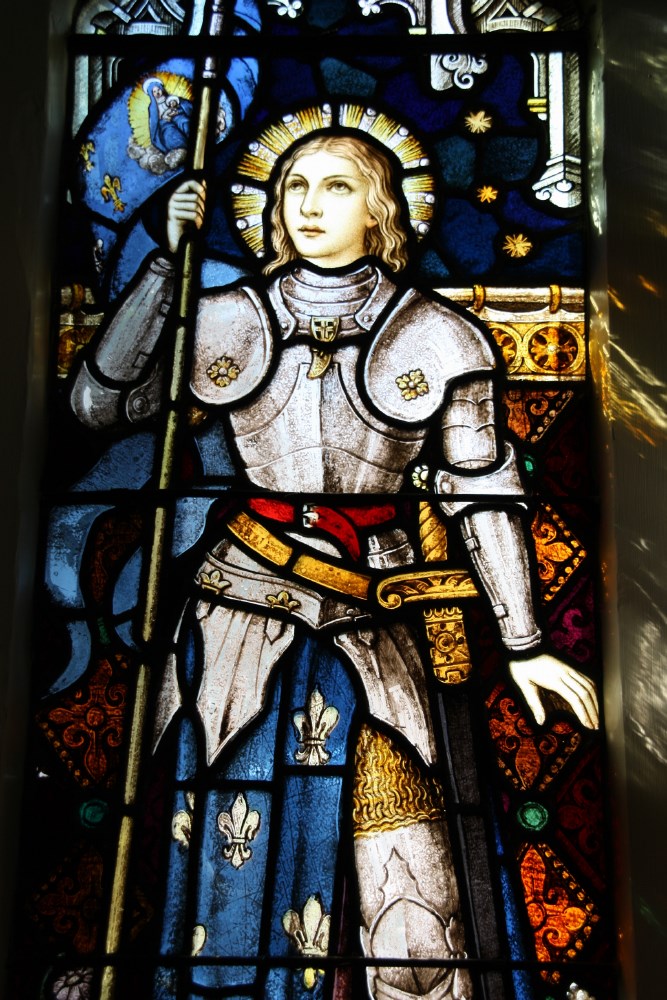 Stained glass in St Mary of the Angels, Wellington, New Zealand. Roman Catholic church.
Stained glass in St Mary of the Angels, Wellington, New Zealand. Roman Catholic church.
Famous national heroine of France: Saint Joan of Arc.
* * *
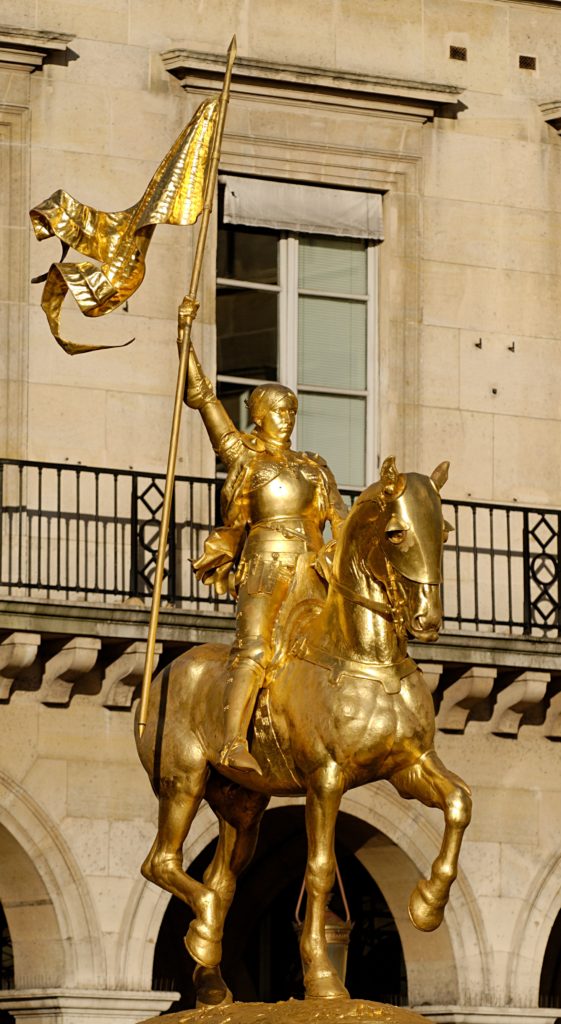 Gilded bronze equestrian statue of Joan of Arc at Place des Pyramides in Paris,
Gilded bronze equestrian statue of Joan of Arc at Place des Pyramides in Paris,
by Emmanuel Frémiet, 1874
Credit: – Own work (own picture)
* * *
This bell is located in the Cathedral of the fortress town of Orleans, France. The surrounding area was the scene of Jeanne’s first, and perhaps most dramatic, victory. This battle succeeded in freeing Orleans and nearby areas from English control. It also shifted the momentum of the war to the side of the French army, which was under the command of Jeanne d’Arc.
A translation might read: “The King of Heaven appoints (sends) Jeanne d’Arc (for this mission).”
Credit: CNXMTH Image of Joan of Arc on bell, Orleans Cathedral, France. Image shot 2012. Exact date unknown.
* * *

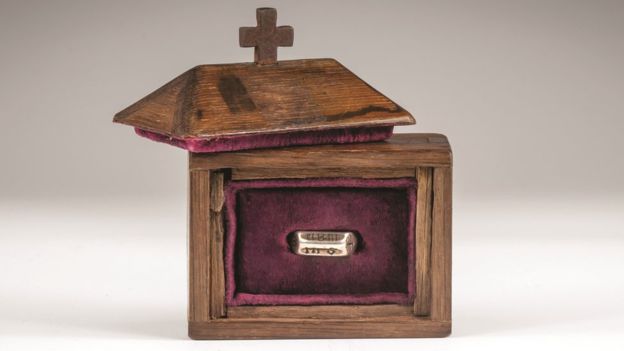 See our RING OF JOAN OF ARC FOUND! page to read the full information.
See our RING OF JOAN OF ARC FOUND! page to read the full information.
Her ring was sold for $425,000 in March 2016, and it has returned to France after nearly 600 years in England.
The purchaser, Puy du Fou foundation, runs a historical theme park near Nantes in western France.
The foundation appealed to donors to help it bid enough for the ring, which was officially unveiled in March 2016.
* * *
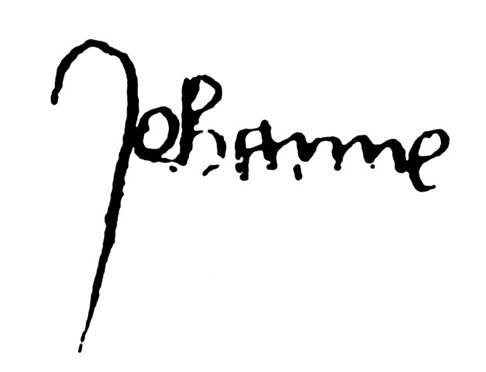
![]() Jehanne’s signature from a document she signed during the military campaigns.
Jehanne’s signature from a document she signed during the military campaigns.
Credit: Signature of Joan of Arc: Mary Ann De Vera.
* * *

